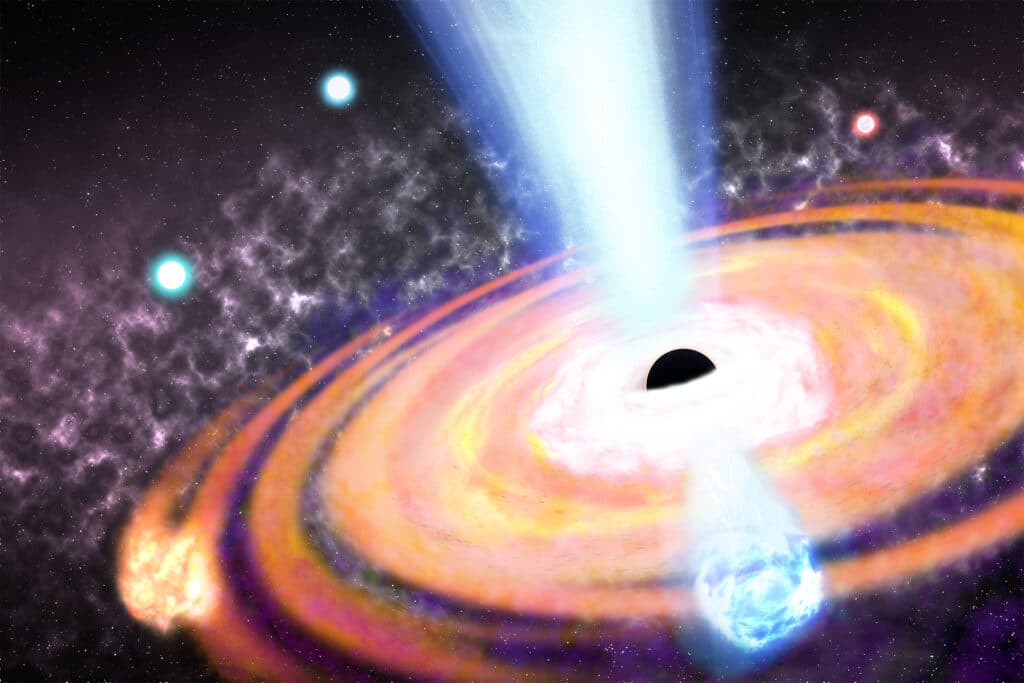A supermassive black hole from the dawn of the universe was hiding behind a thick veil of cosmic dust. This monumental finding, made possible by NASA’s James Webb Space Telescope (JWST), offers new insights into the enigmatic relationship between black holes and the galaxies that host them.
The discovery was led by a dedicated team of astronomers from Ben-Gurion University of the Negev in Israel, who stumbled upon an extremely red, gravitationally lensed supermassive black hole. This cosmic giant, notable for its massive size relative to its host galaxy, was identified through the JWST’s advanced imaging capabilities.
Launched two years ago, the JWST has already revolutionized our understanding of early galaxy formation, uncovering a plethora of early galaxies with unexpected brightness and abundance. Among these findings, the detection of a lensed, quasar-like object stands out for its unique characteristics and implications for astrophysics.
Quasars, or supermassive black holes actively accreting material at the centers of galaxies, emit vast amounts of radiation, making them some of the brightest objects in the universe. The object appeared as a compact, intensely red “dot” in images taken by the JWST for the UNCOVER program. This program focused on the galaxy cluster Abell 2744, utilizing the phenomenon of gravitational lensing where the cluster’s massive gravitational field bends spacetime, magnifying distant galaxies behind it and allowing astronomers to peer further back in time than ever before.
“We were very excited when JWST started sending its first data. We were scanning the data that arrived for the UNCOVER program and three very compact yet red-blooming objects prominently stood out and caught our eyes,” says study lead author Dr. Lukas Furtak, a postdoctoral researcher at BGU, in a media release. “Their ‘red-dot’ appearance immediately led us to suspect that it was a quasar-like object.”
This initial observation led to the identification of the objects as multiple images of the same background source, believed to be a supermassive black hole. Further analysis confirmed the team’s hypothesis.
“The spectra were just mind blowing,” notes Ivo Labbé, a professor at Swinburne University of Technology and co-lead of the UNCOVER program. “By combining the signal from the three images together with the lensing magnification, the resulting spectrum is equivalent to ~1700 observing hours by JWST on an unlensed object, making it the deepest spectrum JWST has obtained for a single object in the early universe.”
Surprisingly, the black hole’s mass was found to be significantly larger in proportion to its host galaxy than any similar objects observed in the more immediate universe. This challenges current understandings of black hole and galaxy growth and the dynamics between them.
“All the light of that galaxy must fit within a tiny region the size of a present-day star-cluster. The gravitational lensing magnification of the source gave us exquisite limits on the size. Even packing all the possible stars into such a small region, the black hole ends up being at least 1 percent of the total mass of the system,” explains study lead author Jenny Greene, a professor at Princeton University. “In fact, several other supermassive black-holes in the early universe have now been found to show a similar behavior, which lead to some intriguing views of black hole and host galaxy growth, and the interplay between them, which is not well understood.”
The discovery sheds light on the complex interplay between supermassive black holes and their host galaxies in the early universe, a relationship that remains one of the most fascinating puzzles in astrophysics. As JWST continues to unveil “little red dots” and other active galactic nuclei, astronomers hope to unravel the mysteries of how these giants grew and the impact they had on the cosmos around them.
“In a way, it’s the astrophysical equivalent of the chicken and egg problem,” concludes Adi Zitrin, a professor and astronomer at BGU. “We do not currently know which came first — the galaxy or black hole, how massive the first black holes were, and how they grew.”
The study is published in the journal Nature.













Comments